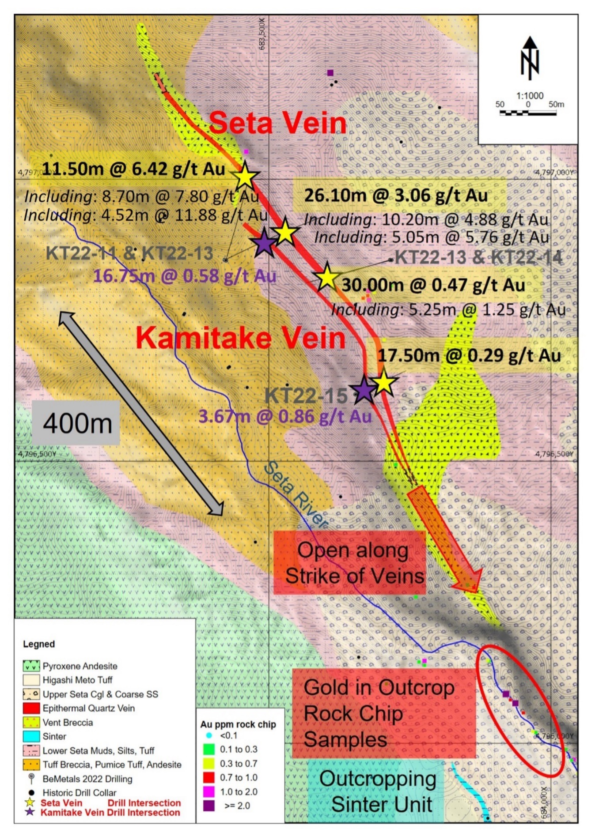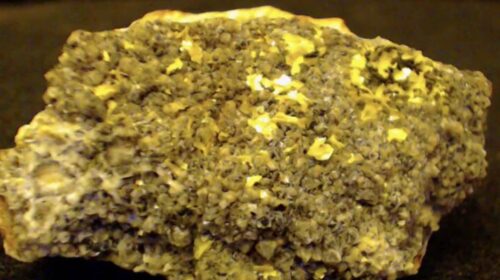BEMETALS FURTHER EXTENDS SETA VEIN AND ADVANCES ALL KAZAN GOLD PROJECTS IN JAPAN
BeMetals is pleased to announce it has further extended the Seta Vein with recently received assay results for drill holes KT22-13 to KT22-15 from its ongoing diamond drilling program at the Kato Gold Project (“Kato” or the “Property”) in Hokkaido. The Company also provides a summary of progress for all its Kazan gold projects in Japan.
John Wilton, President and CEO of BeMetals stated, “We are pleased that the Company’s latest drilling results at the Kato Project successfully extended the Seta Vein Zone some 400 metres along strike from the Company’s first intersection in drill hole KT22-11. In addition, hole KT22-15 has also extended the recently identified Kamitake Vein Zone approximately 350 metres along strike from its first intersection in hole KT22-12. Both the Seta and Kamitake veins appear to be continuing along strike to the southeast for a considerable distance.
Drilling has been paused for a short winter break and will resume next month to test both depth and grade zonation of the Kato mineralization. This phase of drilling will also test exploration targets to the southeast, along strike from our 2022 drilling program.
We also made meaningful progress on the rest of our portfolio of exciting gold exploration properties in Japan. The geological terrain in Japan hosts numerous historical mines including one of the highest-grade gold mines in the world, the multi-million-ounce Hishikari gold mine, currently in production. Until recently, little gold exploration has been conducted in Japan since the mid-1990s.
The discovery potential of the country has generated significant exploration interest from senior gold producers such as B2Gold Corp., a strategic cornerstone investor in BeMetals, and major gold producers including Newmont Corporation and Barrick Gold Corporation. We believe there are very few remaining regions of the world that are under-explored with the pedigree for gold discovery and development potential as provided by Japan.”
2022 KATO PROJECT DRILLING PROGRAM
The drilling to-date at the Kato Project has already successfully extended the high-grade gold zone, along strike of the Seta Vein Zone some 160 metres from the historical intersections of MMAJ completed in the early 1990s. Holes KT22-11 and KT22-12 support this significant extension which returned 6.42 g/t Au over 11.50 metres and 3.06 g/t Au over 26.10 metres respectively. These intersections include 7.80 g/t over 8.70 metres with 11.88 g/t Au over 4.52 metres in KT22-11, and 4.88 g/t Au over 10.20 metres with 5.76 g/t Au over 5.05 metres in KT22-12 (see Figure 1). Table 1 includes details of the drilling results and indicates the relatively shallow depth of these intersections.
In addition, and potentially most importantly the new drilling results from holes KT22-13 and KT22-15 provide further strike extension of the Seta Vein by approximately 400 metres from hole KT22-11. While the grade of the Seta Vein in these two drill holes was 0.47 g/t Au over 30.00 metres, including 1.25 g/t Au over 5.25 metres, and 0.29 g/t Au over 17.50 metres is relatively low. It is interpreted that these holes intersected the upper reaches of the vein where such grades could be expected. Observation of certain quartz vein textures support these intersections being at a relatively high level in the system. Planned drilling in 2023 will test below these latest intersections where improved grade continuity could be expected. This has been seen in other areas of the Project area.
Drill holes KT22-12 and KT22-15 also intersected the recently identified Kamitake Vein Zone close to the Seta Vein. The Kamitake Vein Zone provided grades of 0.58 g/t Au over 16.75 metres including 0.84 g/t Au over 4.65 metres and 0.81 g/t Au over 2.10 metres in KT22-12, and 0.86 g/t Au over 3.67 metres in KT22-15. Figure 1 shows the 350 metres of currently drilled strike extent to the Kamitake Vein Zone.
Figure 1 is a simplified geological map of the Kato Project drilling area and illustrates that both the Seta and Kamitake Vein Zones are open along strike to the southeast. These mineralized veins are trending towards an area where high-grade outcrop rock chip samples were taken in the Seta River valley. All the data to-date, provide compelling drill targets for our upcoming 2023 drilling campaign to commence in February.
During the recently completed drilling campaign, additional drilling equipment was used that appears to improve drilling efficiency in the shallow, highly altered units of the host rocks. BeMetals also plans to test other advanced core drilling technology to further improve drill productivity and core recovery.
Figure 1: Location Map of Holes KT22-11 to KT22-15 at Kato Gold Project

Note: Results of the historical rock chip sampling have been previously reported reported, and are detailed in the Company’s technical report entitled, “Kato Gold Project Japan NI 43-101 Technical Report” with an effective date of July 13, 2021.
Table 1 below lists the gold intersections returned during the 2022 drilling program at the Kato Project and includes both the Seta and Kamitake Vein intersections with surrounding mineralized stockwork zones. Table 2 provides details of the drill hole locations, dips, and azimuth.
Table 1: Drill Hole Intersection Results Holes KT22-11 to KT22-15
| Drill hole and Interval | From (m) | To (m) | Core Interval(m) | Au g/t | Comments |
| KT22-11: Seta Vein Zone | |||||
| Interval 1: | 226.00 | 236.80 | 10.80 | 0.43 | Stockwork Zone |
| Interval 2: | 236.80 | 248.30 | 11.50 | 6.42 | Vein Zone |
| Including: | 239.60 | 248.30 | 8.70* | 7.80 | |
| Including: | 239.60 | 244.12 | 4.52 | 11.88 | |
| Interval 3: | 248.30 | 253.20 | 4.90 | 0.76 | Stockwork Zone (1) |
| KT22-12: | |||||
| Interval 1: Kamitake Vein | 172.25 | 189.00 | 16.75 | 0.58 | Kamitake Vein Zone (1) |
| Including: | 178.05 | 182.70 | 4.65 | 0.84 | Interpreted Upper Zone of Kamitake Vein |
| Also Including: | 186.90 | 189.00 | 2.10 | 0.81 | Interpreted Upper Zone of Kamitake Vein |
| Interval 2: | 229.00 | 237.00 | 8.00 | 0.57 | Stockwork Zone (1) |
| Interval 3: Seta Vein | 237.00 | 263.10 | 26.10 | 3.06 | Vein Zone |
| Including: | 239.70 | 249.90 | 10.20 | 4.88 | |
| Including: | 239.70 | 244.75 | 5.05† | 5.76 | |
| KT22-13: Seta Vein Zone | |||||
| Interval 1: | 183.60 | 188.20 | 4.60 | 0.48 | Stockwork Zone (1) |
| Interval 2: | 199.00 | 213.00 | 14.00 | 0.31 | Vein Zone |
| Interval 3: | 213.00 | 243.00 | 30.00 | 0.47 | Vein Zone |
| Including: | 213.00 | 218.25 | 5.25 | 1.25 | |
| Including: | 217.70 | 218.25 | 0.55 | 3.12 | |
| KT22-14 | Remained in footwall of Seta Vein and did not intersect vein mineralization | ||||
| KT22-15 | |||||
| Interval 1: Kamitake Vein | 50.83 | 54.50 | 3.67 | 0.86 | Interpreted Upper Zone of Kamitake Vein (1) |
| Interval 2: Seta Vein | 199.25 | 216.75 | 17.50 | 0.29 | Interpreted Upper Zone of Seta Vein |
| Including: | 199.25 | 201.90 | 2.65 | 0.43 | |
| Including: | 206.81 | 208.00 | 1.19 | 0.43 | |
| Including: | 211.20 | 213.38 | 2.18 | 0.44 | |
| Including: | 215.30 | 216.75 | 1.45 | 0.45 |
Table 1 Notes: Intertek Testing Services completed the analytical work with the core samples processed at their accredited laboratory in Manila, Philippines (See details in QA/QA section below). Reported widths are drilled core lengths as true widths are unknown at this time. Based upon current data it is estimated true widths range between 35 to 65% of the drilled intersections. For the Stockwork Zone a nominal cut-off grade of 0.30 g/t Au has been used to determine the boundaries of the intersections with no more than 1.30 metres of internal dilution of the intercept. For the Seta Vein a nominal cut-off grade of 1 g/t Au has been used to determine the boundaries of the intersections with no more than 4.84m internal dilution of the intercepts. *A nominal cut-off grade of 3 g/t has been used to determine the boundaries of this intersection with no more than 2.08 metres of internal dilution. †A nominal cut-off grade of 5 g/t has been used to determine the boundaries of this intersection with no more than 1.91 meters of internal dilution. (1) current interpretation
Table 2: Core Hole ID, Azimuth, Dip, End of Hole Depth and Collar Coordinates
| Drill Hole ID | Azimuth Degree | Dip Degree | End of hole Depth (m) | Easting (m) | Northing (m) | Elevation (m) |
| KT22-11 | 015 | -53 | 253.20 | 683424 | 4796856 | 497 |
| KT22-12 | 065 | -60 | 399.00 | 683422 | 4796857 | 495 |
| KT22-13 | 255 | -60 | 254.40 | 683715 | 4796857 | 542 |
| KT22-14 | 255 | -68 | 405.50 | 683717 | 4796856 | 542 |
| KT22-15 | 065 | -74 | 237.90 | 683653 | 4796618 | 493 |
THE KATO GOLD PROJECT
The Kato Gold Project is BeMetals’ most advanced, of five exploration projects in Japan based on the amount of available historical drilling information in central Hokkaido (See Figure 2). The Kato Project (historically referred to as the Seta River Prospect) is an example of a remarkably well-preserved epithermal gold system. This mineralization style is an example of an epithermal system and the classic analogy for this mineralization type in Japan is the Hishikari Gold Mine, on Kyushu. Global examples of this type of mineralization include mines such as Lihir (Papua New Guinea), Kupol and Julietta (Russia), Waihi (New Zealand) and Masbate (Philippines).*
The Property was previously drilled by the Japanese state agency MMAJ in the 1990s and during that time results included high-grade intervals of gold such as 17.5 metres grading 8.15 g/t Au in hole 5MAHB-2 and 18.65 metres grading 5.01 g/t Au in hole 7MAHB-1.*
OTHER KAZAN GOLD EXPLORATION PROPERTIES: TODOROKI, KONOMAI, TASHIRO AND HOKUSATSU PROJECTS
Figure 2 shows the locations of all the Kazan gold projects in Japan. At the Todoroki Gold-Silver Project (“Todoroki”) in western Hokkaido the Company completed a phase of geological compilation and target generation based upon rock chip and cut channel sampling with geological mapping completed during the year. This data has been integrated with historical data from the past producing Todoroki Gold Mine. This combined work has led to the generation of robust targets for drill testing during the 2023 field season.
Such targets, if successfully drilled would provide material extensions to the Todoroki vein swarm, many of which were historically mined in certain areas. Available records indicate that some 200,000 ounces of gold, and 7.4 million ounces of silver were produced at Todoroki up to 1943. Following WW2, mining continued intermittently until the 1980s but production information for this period is uncertain.
At the Company’s Konomai Project in northern Hokkaido, a soil and rock chip sampling program was completed near the historical Otowa Gold Mine on the Konomai property. When the full set of results are available these will be integrated with existing data to generate targets for follow-up exploration.
In Kyushu, BeMetals received permission from the civil aviation authority and will complete an airborne drone magnetic survey at the Tashiro Project. Also, the Company will undertake a mapping and sampling program at the Hokusatsu Project.
Figure 2. Location of BeMetals Kazan Gold Projects in Japan

QUALITY ASSURANCE AND QUALITY CONTROL
The new results reported here for this core drilling program were analyzed by Intertek Testing Services, an independent and accredited laboratory. Samples were prepared and analytical work conducted in Manila, Philippines. The results were obtained using the following analytical methods as appropriate to determine the gold grades; FA50N/AA of 50g fire assay, with Atomic Absorption Spectrometry (“AAS”) finish and FA50GR/GR of 50g fire assay with Gravimetric finish for over limit samples exceeding 10 g/t Au. The core sampling was conducted with a robust sampling protocol that included the appropriate insertion of standard reference material, duplicates, and blanks into the sample stream.
Field operations and management have been conducted by BeMetals’ personnel. The core drilling was conducted by Energold Drilling.
ABOUT BEMETALS CORP.
BeMetals is a precious and base metals exploration and development company focused on becoming a leading metal producer through the acquisition of quality exploration, development and potentially production stage projects. The Company has established itself in the gold sector with the acquisition of a portfolio of wholly owned exploration projects in Japan. BeMetals is also progressing its tier-one targeted, Pangeni Copper Exploration Project in the prolific Zambian Copperbelt with co-funding investor the Japanese state agency JOGMEC (“Japan Organization for Metals and Energy Security”). Guiding and leading BeMetals’ growth strategy is a strong board and management team, founders and significant shareholders of the Company, who have an extensive proven record of delivering exceptional value in the mining sector, over many decades, through the discovery, construction and operation of mines around the world.
105 total views , 1 views today





